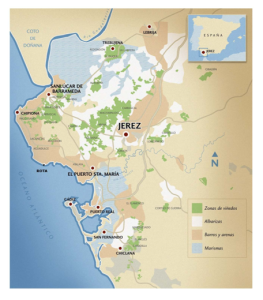News flash from the Government of Andalucía (Junta de Andalucía), the Spanish Ministry of Agriculture (Ministerio de Agricultura, Pesca y Alimentación), and the European Commission: some substantial updates have been made to the rules and regulations regarding the Manzanilla Sanlúcar de Barrameda DO.
These changes relate to the widely reported and much-anticipated revisions that are underway for the larger Jerez-Xérès-Sherry DO. However, these updates—concerning Manzanilla—stand on their own. (For the record, the expected updates to the Jerez-Xérès-Sherry DO are still awaiting publication on the website of the Ministerio de Agricultura, Pesca y Alimentación and approval of the EU/European Commission.)
The substantive changes to the Manzanilla Sanlúcar de Barrameda DO include the following:
- The name “Manzanilla/Manzanilla DO” is added as a protected term—equivalent to the still-applicable “Manzanilla Sanlúcar de Barrameda DO”.
- The minimum required sugar content has been lowered (from 5 grams per liter) to 4 g/L.
- The requirement for Manzanilla products to be fortified (vinos generosos) remains; however, the language has been updated to reflect the term fortificación, rather than the archaic term encabezado (as used previously).
-
A minimum 7-year oak aging period has been specified for Manzanilla Pasada (this replaces the much less specific requirement for prolonged maturing).
- Palomino (aka Palomino Fino or Listán Blanco) is the only grape now allowed for use in Manzanilla DO. (This means that Pedro Ximenez and Moscatel are no longer approved.)
- The new document confirms the standard that grapes used in the production of Manzanilla DO may be grown anywhere within the confines of the Jerez-Xérès-Sherry DO, but specifies that the product must be aged (in oak barrels for at least two years) within the confines of the municipality of Sanlúcar de Barrameda.
The location of Sanlúcar de Barrameda—on the Atlantic coast and adjacent to the Guadalquivir River—provides an ideal (warm and humid) environment for intense flor yeast activity. As stated on the updated pliego de condiciones for the Manzanilla DO, la proximité de la mer et le niveau élevé d’humidité favorisent une activité intense et prolongée de la levure, qui confère au vin Manzanilla des caractéristiques particulières. (“The proximity to the sea and the high humidity are conducive to intense yeast activity over a long period of time, giving Manzanilla wines their unique characteristics.”)
References/for more information:
Post authored by Jane A. Nickles…your blog administrator: jnickles@societyofwineeducators.org

